

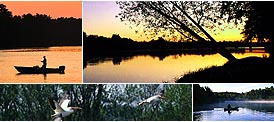
Southwest Florida
Wildlife Photos
Alligator Snapping Turtle
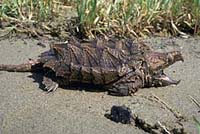 The Alligator Snapping Turtle is a very large freshwater turtle and is a common resident of Florida. Can be found in rivers, canals, swamps and lakes. Also lives in other Gulf Coast states and occasionally travels as far north as Ohio and Illinois.
The Alligator Snapping Turtle is a very large freshwater turtle and is a common resident of Florida. Can be found in rivers, canals, swamps and lakes. Also lives in other Gulf Coast states and occasionally travels as far north as Ohio and Illinois.
It has a large head with a hooked beak and powerful jaws. It can grow up to 200 pounds and more than two feet long. Although they spend most of their lives in the water, they are not good swimmers. Instead of swimming they walk along the bottom, and occasionally make their way to the surface to breath. The alligator snapping turtle can live up to 150 years old.
American Alligator
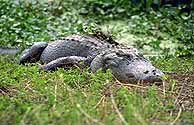 Found in freshwater throughout the state. It has a large (10-19') black body with a broad, rounded snout and lives an average of 40 years. It has excellent eyesight even at night. Its jaws hold 70-80 pointed teeth. If a tooth is lost, a new one grows in its place. It feeds on fish, turtles, water birds, snakes, frogs, and small mammals.
The alligator swims by tucking its legs against its body and sweeping its tail from side to side. It is capable of sudden bursts of speed in the water and on land.
Active during warmer months, alligators may stay secluded underwater or in shoreline dens during colder months. If resting, they can stay underwater for an hour or even several hours. They tend to wander during droughts and mating season.
Hunted almost to extinction, alligator hunting was banned in the early 1960's, and is now strictly regulated. Alligator farming now accounts for most of the hides and meat on the market.
Alligators bellow, loudly! Apparently gators bellow for the sheer sake of bellowing -- it hasn't been linked to hostile or mating behavior. Just before a male bellows, he performs a "water dance", vibrating his whole torso. At the same time, he issues low notes, too low to be heard by humans, that can be heard by other alligators at long distances. Females bellow but not as loudly. Females grunt to call their young. All alligators hiss.
Found in freshwater throughout the state. It has a large (10-19') black body with a broad, rounded snout and lives an average of 40 years. It has excellent eyesight even at night. Its jaws hold 70-80 pointed teeth. If a tooth is lost, a new one grows in its place. It feeds on fish, turtles, water birds, snakes, frogs, and small mammals.
The alligator swims by tucking its legs against its body and sweeping its tail from side to side. It is capable of sudden bursts of speed in the water and on land.
Active during warmer months, alligators may stay secluded underwater or in shoreline dens during colder months. If resting, they can stay underwater for an hour or even several hours. They tend to wander during droughts and mating season.
Hunted almost to extinction, alligator hunting was banned in the early 1960's, and is now strictly regulated. Alligator farming now accounts for most of the hides and meat on the market.
Alligators bellow, loudly! Apparently gators bellow for the sheer sake of bellowing -- it hasn't been linked to hostile or mating behavior. Just before a male bellows, he performs a "water dance", vibrating his whole torso. At the same time, he issues low notes, too low to be heard by humans, that can be heard by other alligators at long distances. Females bellow but not as loudly. Females grunt to call their young. All alligators hiss.
Like crocodiles and most turtles, alligators lack sex chromosomes. The sex of the offspring is determined by the incubation temperature of the eggs. Alligator eggs that incubate at 82-86°F become females and those at 90-93°F become males. Eggs that incubate in the middle range result in an equal number of males and females.
Armadillo
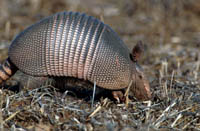 Introduced to Florida in the early 1900's, is found statewide in areas with dense ground cover and sandy soil. It is covered with stiff, bony plates. Nine bands of plates cover the body from shoulder to hip and 12 bands cover the long tail. It has a small, tapered head and snout and a long tongue. Its ears are long and hairless. It has sparse white hairs on its belly. It is primarily nocturnal, sedentary, solitary, and a burrower. It digs a series of dens. The multiple entrances are usually protected by stumps, palmettos, or trees. Many other animals also use armadillo dens.
Introduced to Florida in the early 1900's, is found statewide in areas with dense ground cover and sandy soil. It is covered with stiff, bony plates. Nine bands of plates cover the body from shoulder to hip and 12 bands cover the long tail. It has a small, tapered head and snout and a long tongue. Its ears are long and hairless. It has sparse white hairs on its belly. It is primarily nocturnal, sedentary, solitary, and a burrower. It digs a series of dens. The multiple entrances are usually protected by stumps, palmettos, or trees. Many other animals also use armadillo dens.
Its diet is composed of insects, especially beetles, and other invertebrates plus some plant foods such as cedars and beautyberries. Armadillos breed in July or August. Each litter is composed of identical quadruplets, the result of a single egg splitting. All are either male or female. Litters are usually born in March or April. The young begin following the mother the day they are born. When pursued, an armadillo can dig a burrow and disappear in just a few seconds. The nine-banded armadillo cannot roll into a ball to protect itself but a South American armadillo can. Predators include man, dogs, bobcats, coyotes, black bears, panthers, and foxes. Armadillos (Dasypodidae) are the only mammals in Florida with an exoskeleton. A small percentage of armadillos carry leprosy.
Cuban Treefrog
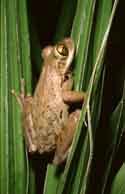 Introduced into south Florida from Cuba, is found in central and south Florida and often seen clinging to windows and sliding glass doors. It is the largest treefrog in Florida (5.5") and eats the smaller native frogs. It can change colors from light gray or pale green to dark brown. Its skin secretions can be irritating.
Introduced into south Florida from Cuba, is found in central and south Florida and often seen clinging to windows and sliding glass doors. It is the largest treefrog in Florida (5.5") and eats the smaller native frogs. It can change colors from light gray or pale green to dark brown. Its skin secretions can be irritating.
Nocturnal. Highly predaceous, it will eat anything it can catch and swallow, including insects, spiders, and other frogs. The Cuban Treefrog is most abundant around ornamental fish ponds and well-lighted patios and can be found on highway billboards, hiding among the timbers during the day or feeding on insects attracted to the night lights. This species was probably introduced by accident into Key West on vegetable produce brought from Cuba early in the century. It continues to spread on the Florida mainland by hitchhiking on crates and transplanted shrubs.
 Dragonfly
Dragonfly
Dragonflies are fierce hunters and the skim over the water of streams and ponds in search of prey.
When a female is ready to mate there are eggs already in her body. As she flies, a male dragonfly comes to join her. Still flying, the two of them cling together and mate in the air. The female then goes down to the surface of a pond and hovers beside a stem growing there. The female dips her abdomen into the water and pushes her egges into the stem of the plant. There they will be protected until they are ready to hatch. Soon a little nymph will hatch.
Feral Pig
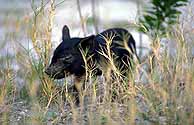 Introduced to Florida in the 1500's and is now found statewide in wooded areas close to water. Appearance is similar to domestic hogs, but leaner, with a longer, narrower head and a coarser, denser coat. Males have 2-5" long razor-sharp tusks. It is usually black though may be spotted or mottled. The tusks of females are much smaller. Overall body length is 50-78" with a 9-13" tail.
Introduced to Florida in the 1500's and is now found statewide in wooded areas close to water. Appearance is similar to domestic hogs, but leaner, with a longer, narrower head and a coarser, denser coat. Males have 2-5" long razor-sharp tusks. It is usually black though may be spotted or mottled. The tusks of females are much smaller. Overall body length is 50-78" with a 9-13" tail.
Males tend to be solitary, but several females and their offspring may remain together. Breeding occurs at any time of the year, with litters of 1-12 piglets born about 114 days later. The piglets are weaned in a few weeks but remain with the mother for several months. Females may have two litters per year.
It is an omnivore, foraging on the ground and rooting just beneath the surface, which damages the ground cover. Diet includes acorns and other nuts, mushrooms, fruits, small animals, birds, and carrion. It is rarely active during the day.
Wild boars are also called "razorbacks" because the hair along the backbone stands erect when the boar is agitated. They tend to retreat when approached but can become vicious when cornered. Natural predators include man, bears, and panthers.
Florida Atala Butterfly
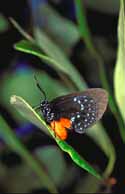 The adult Atala butterfly has a wingspread of 3.6 to 4.8 cm. The wings are black with striking blue spots on the underside hind wings, and a red orange spot at the base of the hind wing near the abdomen. The abdomen of the Atala is bright red, and the head and thorax are black. The Atala caterpillar is orange red with seven pairs of yellow spots running along the dorsal side. Both the butterfly and caterpillar coloring is considered aposematic. These warning colors indicate to the Atala’s predators that its body contains deadly toxins derived from their host plant.
The adult Atala butterfly has a wingspread of 3.6 to 4.8 cm. The wings are black with striking blue spots on the underside hind wings, and a red orange spot at the base of the hind wing near the abdomen. The abdomen of the Atala is bright red, and the head and thorax are black. The Atala caterpillar is orange red with seven pairs of yellow spots running along the dorsal side. Both the butterfly and caterpillar coloring is considered aposematic. These warning colors indicate to the Atala’s predators that its body contains deadly toxins derived from their host plant.
Eumaeus atala has a range throughout Cuba, the Bahamas, Cayman Brac, and southeast Florida (as far north as Indian River and St. Lucie’s counties). Taxonomists debate over whether Eumaeus atala florida is truly a separate subspecies. The habitat of the Atala parallels that of its native larval host, the Florida Coontie, although the Atala does not survive as far north – into Georgia – as the Coontie. The Coontie naturally occurs in habitat dominated by pines and well-drained sandy or loamy soils. This type of plant community is often referred to as southeast Florida’s “Pine Rocklands.”
Florida Panther
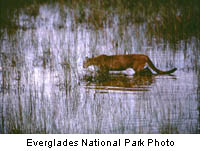 is found primarily in southern Florida in the Everglades and Big Cypress Swamp. It is a large, slender cat with a tawny coat and white belly. Black marks the sides of the muzzle and top of the tail. It has a broad head with small, rounded ears. Length varies from 74-86", and weight ranges from 70-160 pounds. Males are larger than females.
The Florida panther, also called the puma, cougar, catamount and mountain lion remains solitary except when mating and during the period the female raises her young. Known litters have included 1-4 kittens. They remain with the mother for 12-18 months, leaving the nest to accompany her while hunting when they're about 2 months old.
is found primarily in southern Florida in the Everglades and Big Cypress Swamp. It is a large, slender cat with a tawny coat and white belly. Black marks the sides of the muzzle and top of the tail. It has a broad head with small, rounded ears. Length varies from 74-86", and weight ranges from 70-160 pounds. Males are larger than females.
The Florida panther, also called the puma, cougar, catamount and mountain lion remains solitary except when mating and during the period the female raises her young. Known litters have included 1-4 kittens. They remain with the mother for 12-18 months, leaving the nest to accompany her while hunting when they're about 2 months old.
The panther prefers true wilderness habitats, actively avoiding humans. It is usually inactive during the day except in winter. It needs a large area for hunting, as it usually moves 15-20 miles per day. It feeds primarily on wild hogs and white-tailed deer, but will eat smaller mammals. It will occasionally kill livestock; however, there has never been a panther attack on a human.
In 1958, the Florida panther was declared an endangered species. Today there are only 30-50 left. Humans and dogs are their only predators. From 1978 to 1988, there were 20 known panther deaths. Of these, 11 were the result of vehicle collisions and 5 were shootings. In Collier County fences have been placed along Interstate 75 with tunnels every few miles. Panthers are using the tunnels.
Gopher Tortoise
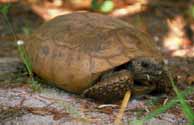 The Gopher Turtle or Tortoise, Gopherus polypnemus, is found in areas with dry ground in north and central Florida. Juveniles have bright tan and brown shells while the shells of adults are darker. The front legs are flat and heavily scaled. They reach a length of 12".
The Gopher Turtle or Tortoise, Gopherus polypnemus, is found in areas with dry ground in north and central Florida. Juveniles have bright tan and brown shells while the shells of adults are darker. The front legs are flat and heavily scaled. They reach a length of 12".
Gopher Tortoises create burrows up to 30 feet long with dens at the ends. The burrows are used by over 300 species of animals who use them for protection against bad weather, predators, and fire. They browse on low growing vegetation including wiregrass, broadleaf grasses, legumes, and fruit such as gopher apples, pawpaws, blackberries, prickly pears, and saw palmetto berries.
Gopher Tortoises usually mate during April and May. Several weeks later the female lays 4-7 eggs in a sand mound near her burrow. The eggs hatch about 80 days later. The young either move into the mother's burrow or dig a small burrow nearby. However, many nests are lost to predators and it may be up to 10 years before she has a successful clutch.
Great Southern Whites
 Are one of five white butterflies commonly found in Florida. They stay near the coasts, flying year-round in southern Florida and during the warmer months in the central and northern peninsula. Spanish needles, a weedy wildflower, is a favorite nectar plant as are lantanas and verbenas. The butterflies are often seen visiting the flowers in open areas on and near the beaches -- along roads and in parks, fields, and gardens.
Are one of five white butterflies commonly found in Florida. They stay near the coasts, flying year-round in southern Florida and during the warmer months in the central and northern peninsula. Spanish needles, a weedy wildflower, is a favorite nectar plant as are lantanas and verbenas. The butterflies are often seen visiting the flowers in open areas on and near the beaches -- along roads and in parks, fields, and gardens.
The adult butterflies have a wingspan of 1.75-2.25". Females may be dark gray in summer. The average lifespan of males is 5 days; of females, 8-10 days. Some Great Southern Whites migrate when temperatures are in the mid-70's (°F) or above. Typical migrations are 20-40 miles and last two days or less. Movement is usually northward in summer and southward in winter.
Saltwort is the primary host plant in Florida. Mustards, particularly pepper grass, and capers may also be used. The eggs are pale yellow and are not harmed by salt water. The caterpillars are yellowish with dark greenish stripes.
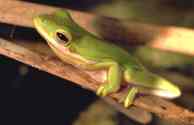 Green Treefrog
Green Treefrog
The Green Treefrog, Hyla cinerea, is found near wetlands statewide. It is usually vivid green but can change to dull gray green. It has a wide white stripe with dark borders down each side. It is 2.25" long. Its call, heard on humid evenings from April through October, is a continuous "gronk-gronk-gronk".
Hermit Crab
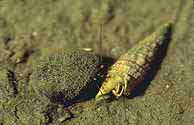 Usually the entire body of Crabs is covered with a hard, calcified armour.
The Hermit Crab however lacks this protection on the hindmost part of its body, the abdomen, which is soft and vulnerable. It protects its abdomen, which contains such important organs as the liver and the gonads, by inserting it into a gastropod shell
For this purpose the abdomen is bent, so that it fits in the curvature of the snail-house.
The outer bend of the abdomen bears some little appendages which enable the crab to hold on to the inside of the shell. The reduced 4th and 5th pairs of legs serve the same purpose
When walking the animal drags its house along. In water the weight of the shell is diminished by the upward pressure and so the Hermit Crab, in spite of its burden, can zealously run about
In case of danger the Hermit Crab withdraws into the shell as deep as possible. In the shell there is no room for two big pincers. Therefore the Hermit Crab has but one. When hiding in the shell it uses this pincer to guard the entrance.
When the crab grows and does not fit in its shell any longer, it looks for a bigger one. The original occupant, if still present, is picked out. Then, quickly and nervously, the crab moves over into its new home.
Usually the entire body of Crabs is covered with a hard, calcified armour.
The Hermit Crab however lacks this protection on the hindmost part of its body, the abdomen, which is soft and vulnerable. It protects its abdomen, which contains such important organs as the liver and the gonads, by inserting it into a gastropod shell
For this purpose the abdomen is bent, so that it fits in the curvature of the snail-house.
The outer bend of the abdomen bears some little appendages which enable the crab to hold on to the inside of the shell. The reduced 4th and 5th pairs of legs serve the same purpose
When walking the animal drags its house along. In water the weight of the shell is diminished by the upward pressure and so the Hermit Crab, in spite of its burden, can zealously run about
In case of danger the Hermit Crab withdraws into the shell as deep as possible. In the shell there is no room for two big pincers. Therefore the Hermit Crab has but one. When hiding in the shell it uses this pincer to guard the entrance.
When the crab grows and does not fit in its shell any longer, it looks for a bigger one. The original occupant, if still present, is picked out. Then, quickly and nervously, the crab moves over into its new home.
Horseshoe Crab
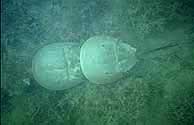 With its hard brown shell, hidden underbody, numerous claw-tipped legs, and long pointy tail appendage, there really isn't anything else that looks much like a horseshoe crab (Limulus polyphemus). Have no fear, for while this ancient creature may appear frightening, it is actually harmless to humans. Looking from above, the horseshoe crab has three distinct parts. The front, larger portion of the hard body with the rounded edge is called the prosoma, or cephalothorax. This body section harbors the crab's eyes and covers its mouth and legs. The prosoma is hinged onto the rear body section, or abdomen, which is edged by spines and which protects the crab's reproductive organs. The long spiked tail, or telson, is used to flip the crab back to an upright position after it has been turned upside down by a wave.
With its hard brown shell, hidden underbody, numerous claw-tipped legs, and long pointy tail appendage, there really isn't anything else that looks much like a horseshoe crab (Limulus polyphemus). Have no fear, for while this ancient creature may appear frightening, it is actually harmless to humans. Looking from above, the horseshoe crab has three distinct parts. The front, larger portion of the hard body with the rounded edge is called the prosoma, or cephalothorax. This body section harbors the crab's eyes and covers its mouth and legs. The prosoma is hinged onto the rear body section, or abdomen, which is edged by spines and which protects the crab's reproductive organs. The long spiked tail, or telson, is used to flip the crab back to an upright position after it has been turned upside down by a wave.
Manatees
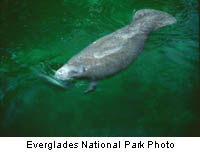 The Florida Manatee, Trichechus manatus latirostris, is gray with a broad, square, bristled snout. It reaches a length of 8-14 feet and may weigh 600-2000 pounds (average 10', 1000 pounds).
It migrates seasonally. During the warmer months, the Florida manatee is found in bays and estuaries along both coasts. During cooler months, unable to tolerate water temperatures below 65°F, manatees congregate in large groups in warm waters, such as spring-fed rivers and industrial plant outflows.
The Florida Manatee, Trichechus manatus latirostris, is gray with a broad, square, bristled snout. It reaches a length of 8-14 feet and may weigh 600-2000 pounds (average 10', 1000 pounds).
It migrates seasonally. During the warmer months, the Florida manatee is found in bays and estuaries along both coasts. During cooler months, unable to tolerate water temperatures below 65°F, manatees congregate in large groups in warm waters, such as spring-fed rivers and industrial plant outflows.
Diet consists of sea- and bank grasses, mangrove, and submerged and floating vegetation. Breeding occurs at any time of the year, but most often in spring and summer. The calf, weighing 30-60 pounds, is born 12-13 months later and will remain with the mother for up to two years. Man is the only predator of adult manatees. Calves are preyed on by alligators, crocodiles, and sharks. The ultimate source of Florida manatee information is the Save the Manatee Club. The Florida Marine Research Institute also has information including photos and mortality statistics. If you see a sick, injured, or dead manatee call 1-800-DIAL-FMP (Florida Marine Patrol).
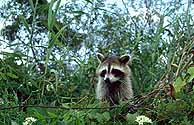 Raccoon
Raccoon
Photos on this page courtesy of SFWMD
There is only one raccoon (Procyonidae) species in Florida.
The Raccoon, Procyon lotor, is found in areas with trees, including urban areas, statewide. It is gray, brown, and black with a pale brown underside. Its face is lighter with a black mask. Its hind legs are longer than its forelegs. It is 30-35" long with a 9-12" banded tail and weighs 10-15 pounds.
It is omnivorous and opportunistic. Its diet includes fruits, nuts, seeds, vegetables, roots, amphibians, reptiles, fish, birds, and insects. It also forages in garbage and has displayed an uncanny ability to open coolers and other camping equipment. Food plants include sea grapes, beautyberry, grapes, pawpaws, Crataegus spp., Rubus spp., oaks, mulberries, cabbage palm, saw palmetto, persimmons, and cactus.
The raccoon typically sleeps in trees during the day, becoming active in the late afternoon. It has several den sites within its home range (1 mile in diameter for males, .75 for females). Breeding usually occurs during December or January. The male wanders off in search of another mate. A litter of 3-4 kits born about 60 days later. The female is very protective of her offspring. Predators include man, dogs, bobcats, panthers, and great horned owls.
River Otter
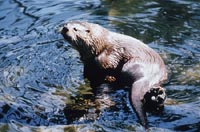 The River Otter, Lutra canadensis, is found in most freshwater habitats in the panhandle and peninsula. It is glossy brown with a paler or gray tan underside. It has an elongated 35-43" body with a long (12-16") muscular tail. It has a small, flattened head, small, rounded ears, short legs, and webbed toes.
It swims at about 6mph and can remain underwater 3-4 minutes. It tends to be nocturnal and lives in bank burrows under tree roots or in dense vegetation.
Diet is mainly fish and crayfish but may include turtles, frogs, snakes, salamanders, clams, birds, rodents, and fruit (such as hawthorn fruit). It caches food.
The river otter breeds in late summer or fall. The litter of 1-6 kits is born about 11 months later. They will stay with the mother about a year.
Predators are alligators and humans.
The River Otter, Lutra canadensis, is found in most freshwater habitats in the panhandle and peninsula. It is glossy brown with a paler or gray tan underside. It has an elongated 35-43" body with a long (12-16") muscular tail. It has a small, flattened head, small, rounded ears, short legs, and webbed toes.
It swims at about 6mph and can remain underwater 3-4 minutes. It tends to be nocturnal and lives in bank burrows under tree roots or in dense vegetation.
Diet is mainly fish and crayfish but may include turtles, frogs, snakes, salamanders, clams, birds, rodents, and fruit (such as hawthorn fruit). It caches food.
The river otter breeds in late summer or fall. The litter of 1-6 kits is born about 11 months later. They will stay with the mother about a year.
Predators are alligators and humans.
 White-tailed Deer
White-tailed Deer
Is found in forest edge habitats statewide. It is gray- to russet brown with a white underside. It is large (55-80") with large ears, a large tail, and long slender legs. Males have antlers. Antlers are largest on males 6-10 years old. They are shed in late winter or early spring and regrow 6-8 weeks later.
It is an herbivore, feeding primarily on twigs and leaves. Its diet also includes acorns, fruits, and mushrooms. Plants attractive to deer include cross vines, Hercules club, persimmons, Smilax spp., sourwood, Persea spp., redbud, buttonbush, ash, Crataegus spp., tupelo and gum trees, and beautyberry. Most browsing is done at night or on overcast days. Breeding season is from September to March. About 200 days later, a litter of 1-3 fawns is born. The young begin accompanying the mother to feed at 3-4 weeks but are not weaned for another 2-3 months and will remain with her until they are 6-18 months old. Predators include man, dogs, bobcats, coyotes, bears, and panthers.
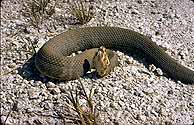 Water Moccasin
Water Moccasin
or cottonmouth, highly venomous snake , Ancistrodon piscivorus, of the swamps and bayous of the S United States. Like the closely related copperhead, it is a pit viper and has a heat-sensitive organ for detecting warm-blooded prey. The young are born live. The young snake is a pale reddish brown with transverse dark brown bands edged with white; as it ages the colors dull to a blotched olive or brown and then to an unmarked olive or blackish in old specimens. The maximum length is 6 ft (2 m), the average from 3 to 4 ft (90-120 cm). A good climber, the water moccasin often relaxes on branches overhanging the water. If startled it erects its head and shows the white interior of its mouthhence the name cottonmouth. It eats both warm-blooded and cold-blooded animals. It is aggressive in the wild state but may become quite tame in captivity. It is classified in the phylum Chordata , subphylum Vertebrata, class Reptilia, order Squamata, family Crotalidae.












